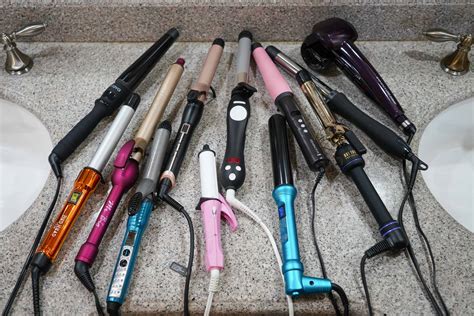Introduction
Choosing the right material for a curling iron is crucial for achieving flawless, long-lasting curls. With so many options available, understanding the pros and cons of each material can help you make an informed decision. In this comprehensive guide, we explore the 5 best materials for curling irons, providing insightful analysis and practical advice to empower you with the knowledge you need to select the perfect tool for your hair type and styling needs.

1. Titanium
Key Benefits:
– Exceptional heat transfer: Titanium conducts heat incredibly well, allowing for quick and even heating that minimizes styling time and reduces damage.
– Durable construction: Known for its strength and longevity, titanium curling irons can withstand high temperatures and frequent use without compromising performance.
– Smooth, shiny curls: Titanium barrels create smooth, polished curls with a lustrous shine.
Considerations:
– Can be expensive: Titanium curling irons tend to be higher priced than other materials.
– May require higher heat settings: Due to its excellent heat transfer, titanium may require slightly higher temperature settings to achieve desired results.
2. Ceramic
Key Benefits:
– Gentle on hair: Ceramic barrels emit negative ions that help seal hair cuticles, reducing frizz and protecting against heat damage.
– Even heat distribution: Ceramic distributes heat evenly, preventing hot spots that can cause hair breakage.
– Affordable: Ceramic curling irons are typically more affordable than titanium or tourmaline options.
Considerations:
– Can be less durable: Ceramic barrels are prone to chipping or damage if dropped or mishandled.
– May require lower heat settings: Ceramic’s slower heat transfer may require lower temperature settings to avoid over-styling.
3. Tourmaline
Key Benefits:
– Abundant negative ions: Tourmaline generates a high concentration of negative ions that neutralize positive ions in the hair, resulting in frizz-free, silky curls.
– Smooth, hydrated curls: The negative ions emitted by tourmaline help retain moisture in the hair, leaving curls with a soft, hydrated feel.
– Versatile: Tourmaline curling irons are suitable for all hair types, from fine and delicate to thick and coarse.
Considerations:
– Can be more expensive: Tourmaline curling irons typically fall within the mid-range to high-end price spectrum.
– May not provide as much heat: Tourmaline’s slower heat transfer may require higher temperature settings to achieve desired results.
4. Gold
Key Benefits:
– Luxurious finish: Gold-plated barrels add a touch of sophistication and elegance to your styling routine.
– Even heat distribution: Gold barrels conduct heat evenly, ensuring consistent results throughout the curling process.
– Gentle on skin: Gold’s inert properties make it less likely to irritate sensitive skin.
Considerations:
– Expensive: Gold-plated curling irons are generally the most expensive option.
– May require higher heat settings: Gold’s poor heat transfer may necessitate using higher temperature settings to achieve desired results.
5. Copper
Key Benefits:
– Exceptional heat retention: Copper barrels retain heat exceptionally well, allowing for fast and efficient styling.
– Less damage: Copper’s superior heat retention enables lower temperature settings, reducing potential heat damage.
– Lightweight: Copper curling irons are lightweight and easy to handle, making them ideal for extended styling sessions.
Considerations:
– Prone to corrosion: Copper is susceptible to corrosion over time, especially in humid environments.
– May require frequent cleaning: Copper barrels can tarnish or discolor with use, requiring regular cleaning to maintain performance.
Factors to Consider When Choosing a Curling Iron Material
Beyond the material, there are several other factors to keep in mind when selecting a curling iron:
- Barrel size: The size of the barrel determines the curl size; larger barrels create loose, beachy waves, while smaller barrels create tighter, more defined curls.
- Heat settings: Look for curling irons with adjustable heat settings to accommodate different hair types and styling needs.
- Cord length: A longer cord provides flexibility and freedom of movement during styling.
- Ergonomic design: Choose a curling iron that fits comfortably in your hand and reduces wrist strain.
Strategies for Curl Longevity
To ensure your curls last throughout the day, follow these effective strategies:
- Use a heat protectant spray: Apply a heat protectant spray to damp hair before curling to minimize heat damage and prevent frizz.
- Curl dry hair: Curling dry hair helps prevent steam damage and creates more defined, long-lasting curls.
- Let curls cool before brushing: Allow curls to cool completely before brushing or combing to avoid disrupting the curl pattern.
- Set curls with hairspray: Spritz a light layer of hairspray over your curls to help them hold their shape.
Tips and Tricks for Perfect Curls
- Section your hair: Divide your hair into sections to ensure even heat distribution and consistent curl formation.
- Curl in small sections: Curling smaller sections of hair creates more defined, longer-lasting curls.
- Hold the iron vertically: Holding the curling iron vertically helps create uniform curls and prevents kinks or bends.
- Experiment with different heat settings: Adjust the heat settings based on your hair type and desired curl size.
Conclusion
Choosing the right material for a curling iron depends on your individual hair type, styling needs, and budget. Titanium, ceramic, tourmaline, gold, and copper each offer unique advantages and considerations. By understanding the characteristics of each material, you can make an informed decision that will help you achieve beautiful, long-lasting curls. Remember to prioritize hair health by using heat protectant sprays and employing gentle styling techniques to maintain the vitality and shine of your locks.
